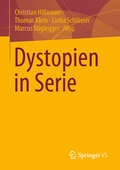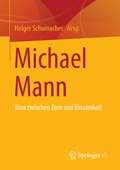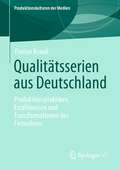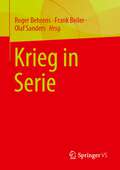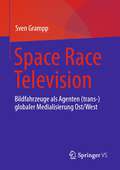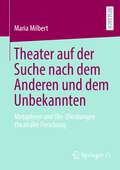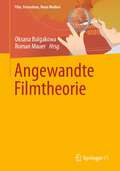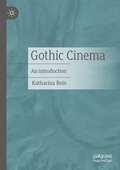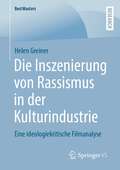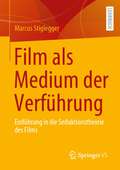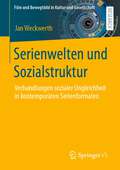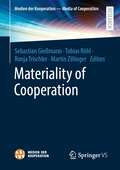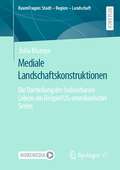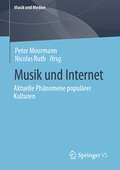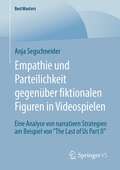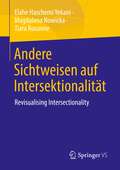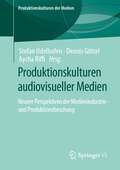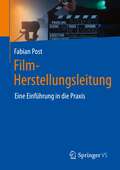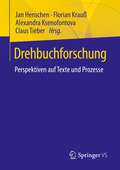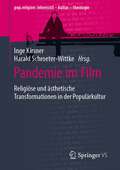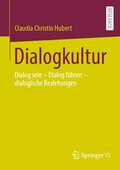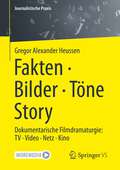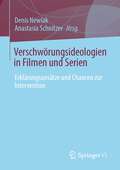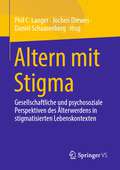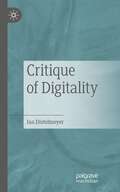- Table View
- List View
Dystopien in Serie
by Marcus Stiglegger Christian Hißnauer Thomas Klein Lioba SchlösserSerielle Dystopien sind omnipräsent; sei es in der Literatur, im Spielfilm, der Fernseh- bzw. Streamingserie oder auch im Videogame. Das Buch verbindet ein wesentliches Erzählverfahren (die Serie) mit gerade kontrovers diskutierten Themen (u.a. Diversity, Covid 19) und dem Genre ihrer medialen Verhandlung. Die Serialität dystopischer Erzählungen ist ein transmediales Phänomen. Der Band geht der Frage nach, wie sich negative Zukunftsvorstellungen, aber auch kontrafaktische Vergangenheitsentwürfe medienspezifisch darstellen, wie sie darüber hinaus im Zuge der Medienkonvergenz größere Erzähluniversen herausbilden. Im Mittelpunkt stehen dabei vor allem Überlegungen, ob sich die serielle Form in besonderer Weise dafür eignet, von dystopischen Gesellschaftsvisionen zu erzählen.
Michael Mann: Kino zwischen Zorn und Einsamkeit
by Holger SchumacherZum ersten Mal widmen sich zehn deutschsprachige Wissenschaftler mit unterschiedlichen Forschungsschwerpunkten dem Gesamtwerk Michael Manns. Dabei werden die Leser*innen zu einer zweifachen Reise eingeladen: Auf einem faszinierenden Tauchgang in die Filmwelt des gefeierten Regisseurs treten zentrale Themen, Figurenkonstellationen, kulturelle Hintergründe und Wirkungseinheiten zutage, die einen völlig neuen Blick auf seine Kunst eröffnen: Wie schafft es Michael Mann seit mehr als 40 Jahren, ein weltweites Publikum zu fesseln und immer wieder aufs Neue in den Kinosaal zu locken? Was verraten seine Filme dadurch über die unbewussten Sehnsüchte, Obsessionen und Widerstände in unserer Kultur? Gleichzeitig entwickelt sich ein spannender Dialog zwischen den verschiedenen Deutungsansätzen: Anhand populärer Kinofilme wie HEAT oder COLLATERAL wecken die wichtigsten Disziplinen - von der Morphologie bis zur Seduktionstheorie - Neugier auf den Facettenreichtum der deutschsprachigen Filmwissenschaft. Auf diese Weise entsteht ein Buch über die Kunst des Films und seiner Interpretation.
Qualitätsserien aus Deutschland: Produktionspraktiken, Erzählweisen und Transformationen des Fernsehens (Produktionskulturen der Medien)
by Florian KraußDas Buch untersucht, wie die Fernsehschaffenden in Deutschland sogenannten Qualitätsfernsehserien von 2015 bis heute entwickeln. Dabei ist die zentrale Hypothese, dass diese Praktiker das Qualitätsfernsehen, das am stärksten mit dem Serien-Drama aus den USA assoziiert wird, in einen nationalen Kontext übertragen und gleichzeitig dieses Konzept mit breiteren, jüngeren Transformationen des Fernsehens und der lokalen Fernsehindustrie verbinden.
Krieg in Serie
by Olaf Sanders Roger Behrens Frank BeilerDieses Buch thematisiert im Rahmen einer interdisziplinär ausgerichteten TV-Serienforschung Beiträge zum besonderen Format der Kriegsserie. Der Bogen der diskutierten Serien reicht von M*A*S*H aus der Zeit des „klassischen“ Fernsehens bis zu neueren und neusten Produktionen, die über Streaming-Dienste angeboten werden wie zum Beispiel Das Boot oder die Bundeswehr-YouTube-Serien Die Rekruten und Mali. Diskutiert werden Kriegsserien in ihren Überschneidungen mit anderen Film- und TV-Genres (Krimiserie: Magnum, p.i., History-Serie: Vikings, Sciencefiction: Battlestar Galactica, Star Trek, auch Philip K. Dick’s Electric Dreams). Im Focus steht überdies die steigende Bedeutung der Kriegsthematik in Serienproduktionen seit der Jahrtausendwende (im Zusammenhang mit den „neuen Kriegen“) wie Band of Brothers, The Pacific oder Generation Kill. Neben den aktualisierenden Untersuchungen geht es schließlich auch um historische Rekonstruktion, wenn Serien wie Combat! bis Over There untersucht werden.
Space Race Television: Bildfahrzeuge als Agenten (trans-)globaler Medialisierung Ost/West
by Sven GramppDer Band bietet eine medientheoretisch ausgerichtete Perspektive auf das Space Race. Analysiert werden Spielfilme, Dokumentationen, Live-Berichterstattung im Fernsehen, Magazine, Briefmarken, Plakate, Konfettiparaden, die das Space Race in je spezifischer Weise ins Bild setzten und von ‚Ost‘ nach ‚West‘ und von ‚West‘ nach ‚Ost‘ transnational über den ‚Eisernen Vorhang‘ hinweg in Umlauf brachten. Gezeigt wird, wie sich die Berichterstattung über das Space Race dabei zwischen 1955 und 1975 als globalisierende Bilder-Verflechtungsgeschichte während des Kalten Krieges nacherzählen lässt.
Theater auf der Suche nach dem Anderen und dem Unbekannten: Metaphern und (Be-)Deutungen theatraler Forschung
by Maria MilbertForschendes Theater, theatrale Feldforschung, performative Forschung – solche Begriffe prägen inzwischen das Theater einschließlich der Theaterpädagogik. Sie stehen dafür, im Rahmen von Gruppenprozessen mit den Mitteln des Theaters zu forschen. Was aber bedeutet hier ‚Forschung‘? In Praxis und Analysen finden sich unterschiedliche, meist in Metaphern ausgedrückte Verständnisse. Die Studie analysiert daher sprachliche Bilder theatralen Forschens mit systematischer Metaphernanalyse, und zwar anhand von Interviews mit Forschenden aus der Theaterkunst, -pädagogik und dem Darstellenden Spiel sowie anhand künstlerischer Theorien. Dabei wird deutlich, dass theatrale Forschung stets eine Auseinandersetzung mit dem Verhältnis von Wissenschaft und Kunst impliziert. Zudem steht sie in einem Spannungsfeld zwischen dem Anderen und dem Unbekannten: Forschende suchen nach neuen Strategien und Erkenntnissen, gehen aber gleichzeitig davon aus, dass ihre Forschung nie abgeschlossen werden kann. Sie zielt auch auf das Nichtwissen, auf individuelle Erfahrung und unrealisierbare Wünsche – auf das Andere.
Angewandte Filmtheorie (Film, Fernsehen, Neue Medien)
by Roman Mauer Oksana BulgakowaWelche Filmtheorie ist hilfreich, um eine Erkenntnisfrage zu klären? Wie wirkt sich die theoretische Perspektive auf die Filmanalyse aus? Diese Fragen bestimmen grundlegend jede Untersuchung. Um den besonderen Fokus einer Theorie offenzulegen, stellt dieses Lehrbuch einen Spielfilm ins Zentrum: Blow Up (GB, I, USA 1966) von Michelangelo Antonioni. Blow Up wird wechselweise beleuchtet aus dem Blickwinkel der Narratologie, Bildtheorie und Musiktheorie, der Stil- und Genretheorie, des Neoformalismus und der quantitativen Filmanalyse, der Psychoanalyse und Gender Studies, der Realismustheorie und des Poststrukturalismus, der Intermedialitätstheorie und der Medienkulturtheorie. Welche Konturen des Films treten im Schlaglicht einer Theorie hervor, welche werden durch sie verborgen? Wie können sich zwei Modelle ergänzen? Wo schließen sie einander aus? Die Beiträge führen in die zentralen Positionen und Kategorien jeder Theorie ein und wenden die Modelle unmittelbar auf den Film an. Um die Besonderheiten der Perspektiven herauszustellen, reflektieren die Autor*innen jeweils abschließend die Analogien, Differenzen und Synergien sowie die Vor- und Nachteile komplementärer Theorien.
Gothic Cinema: An introduction
by Katharina ReinGothic Cinema closes a gap in German-language film discourse: for the first time, the volume sheds light on a hitherto little-discussed film context. It considers Gothic Cinema as a form of unofficial historiography that allows a look not only at the history of film and its technique, but also at moral concepts, gender relations, collective fears or aesthetic currents. A delimitation and definition of the term and the central elements of the Gothic are followed by a comprehensive historical overview from 1896 to the present day. Three in-depth analyses of individual post-2015 gothic films and television series round out the review. On the one hand, the examples examined are representative in terms of typical elements, motifs or topoi, and on the other hand, they exhibit peculiarities and breaks that prove fruitful for a cultural and media studies investigation.
Die Inszenierung von Rassismus in der Kulturindustrie: Eine ideologiekritische Filmanalyse (BestMasters)
by Helen GreinerRassismus zeigt sich auf unterschiedlichste Art und Weise: verbal, in physischer Gewalt, ungleicher Repräsentation, sozialer Segregation oder institutionellem Ausschluss. Diese vielfältigen Erscheinungsformen zeigen, dass es verkürzt wäre, Rassismus auf individuelle Vorurteile zu reduzieren. Aus diesem Grund befasst sich diese Arbeit mit Rassismus in seiner Komplexität zwischen Individuum und Gesellschaft. Der Forschungsgegenstand ist dabei die Kulturindustrie, welche exemplarisch anhand des 2011 erschienenen Hollywood-Films The Help untersucht wird. Die Analyse ist gleitet von der Frage, wie Rassismus im Film dargestellt, von den Rezipient:innen angeeignet und dadurch reproduziert wird. Darüber hinaus werden die internen Widersprüche dieser Darstellung sowie die Mechanismen, die zur Verdeckung dieser Widersprüche führen, herausgearbeitet. Theoretisch stützt sich die Arbeit auf die Einsichten der Kritischen Theorie. Es werden sozialpsychologische sowie ideologiekritische Überlegungen aufeinander bezogen. Dies ermöglicht es, die kulturindustrielle Darstellung von Rassismus in seiner Vielschichtigkeit zu untersuchen und die Wechselwirkung zwischen materiellen Verhältnissen, Ideologie, Kulturindustrie und Subjekt zu betrachten.
Film als Medium der Verführung: Einführung in die Seduktionstheorie des Films
by Marcus StigleggerDie Seduktionstheorie definiert den Film im weiteren Sinne als ein Medium der Verführung, basierend auf dem französischen Begriff der séduction. Es handelt sich um einen von kontinentaler Philosophie und klassischer Filmtheorie geprägten theoretischen Ansatz, mit dem ein dreistufiges Analysemodell verknüpft ist. Das Buch führt in die theoretischen Grundlagen ein und stellt anhand unterschiedlicher klassischer und aktueller Beispiele aus der Filmgeschichte mögliche Analyseansätze vor.
Serienwelten und Sozialstruktur: Verhandlungen sozialer Ungleichheit in kontemporären Serienformaten (Film und Bewegtbild in Kultur und Gesellschaft)
by Jan WeckwerthIn den vergangenen zwei Jahrzehnten haben Fernsehserien, oftmals unter dem Begriff des „Quality TV“ firmierend, eine merkliche kulturelle Aufwertung erfahren. Während der Großteil der Studien den – auch transnational zu verzeichnenden – Erfolg dieser Formate vor allem in ihren narrativen und (audio-)visuellen Innovationen verortet, widmet sich dieser Band der intensiveren Verhandlung des Sozialen in der Serie. Demzufolge besteht ein weiterer bedeutender Faktor für die gestiegene Attraktion von Fernsehserien im detaillierten sozialstrukturellen Aufbau der Seriengesellschaften, in welche die Figuren und ihre Handlungen tief, stimmig und vielschichtig eingebettet sind. Dies lässt die Serienwelt als Ganzes realistischer wirken und sorgt so für eine engere Anbindung an die Alltagskultur ihrer Publika.Ausgehend von diesen Prämissen und auf Basis etablierter Konzeptionen sozialer Ungleichheit wird ein theoretischer wie methodischer Zugang für eine filmsoziologische Analyse sowohl des Sozialraums der Serienwelt als auch der Praxis der darin auftretenden Figuren entwickelt. Die exemplarische Anwendung auf die erste Staffel der Anthologieserie True Detective illustriert die Ausprägungen eines neuen sozialen Realismus, der sich auch in den Publikumsreaktionen auf die einzelnen Episoden niederschlägt.
Materiality of Cooperation (Medien der Kooperation – Media of Cooperation)
by Martin Zillinger Tobias Röhl Sebastian Gießmann Ronja TrischlerThe volume investigates the socio-material dimension and media practices of cooperation – before, during and beyond situations. Cooperation is understood as reciprocal interplay operating with or without consensus, in co-presence or absence of the involved actors in distributed situations. Artefacts, bodies, texts and infrastructures are the media that make cooperation possible. They enable and configure reciprocal accomplishments – and are themselves created through media practices in cooperative situations.
Mediale Landschaftskonstruktionen: Die Darstellung des (sub)urbanen Lebens am Beispiel US-amerikanischer Serien (RaumFragen: Stadt – Region – Landschaft)
by Julia KlumpeIn diesem Buch erfolgen aus sozialkonstruktivistischer Perspektive eine qualitative Repräsentationsanalyse sowie eine quantitative Rezeptionsanalyse der drei US-amerikanischen Serien Gilmore Girls, Desperate Housewives und How I Met Your Mother. Die Autorin untersucht zum einen, welchen Einfluss die in den Serien gezeigten Landschaften auf die Wahrnehmung US-amerikanischer Landschaften durch die Rezipient*innen haben und stellt zum anderen heraus, inwieweit durch die dargestellten Landschaften Idealbilder konstruiert werden. Im Zentrum der Rezeptionsanalyse steht die Korpusanalyse entsprechender Fan-Foren. Untersucht wird, wie filmische Texte, insbesondere filmische Landschaften, in populäre Diskurse eingebettet werden.
Musik und Internet: Aktuelle Phänomene populärer Kulturen (Musik und Medien)
by Peter Moormann Nicolas RuthStreaming-Plattformen und soziale Medien sind geprägt von mannigfaltigen musikalischen Formen und Inhalten. Mit ihren jeweiligen Oberflächen bzw. Gestaltungs- und Kommunikationsrahmen ermöglichen und prägen sie aktuelle Musikkulturen. Neben lang etablierten Formen, wie dem Popsong, die mehr und mehr von den Plattformlogiken und verkürzten Aufmerksamkeitsspannen strukturell beeinflusst werden, finden sich auch zahlreiche neue Phänomene, die sich aus alltäglichen Netzkulturen herausgebildet haben. Durch die unterschiedlichen Perspektiven und Phänomenaspekte des Bandes wird deutlich, wie relevant das Internet für aktuelle Musikkulturen ist und in welch komplexen Konstellationen dabei Musik gestaltet, distribuiert und rezipiert wird.
Empathie und Parteilichkeit gegenüber fiktionalen Figuren in Videospielen: Eine Analyse von narrativen Strategien am Beispiel von “The Last of Us Part II” (BestMasters)
by Anja SegschneiderWie entstehen Empathie und Parteilichkeit in interaktiven Medien? Ausgehend von der These, dass interaktive Medien wie Videospiele eher dazu in der Lage sind, Empathie und Parteilichkeit zu erzeugen als lineare Medien, geht die Arbeit dieser Frage nach. Als Beispiel dient das populäre Survival-Horror-Spiel „The Last of Us Part II“ aus dem Jahr 2020. Das theoretische Fundament bilden bestehende Theorien aus Film- und Medienwissenschaft sowie der Psychologie, die auf das interaktive Medium übertragen und angepasst werden. Ein Fokus liegt auf narrativen und ludonarrativen Strategien. Dabei schlägt die Arbeit auch einen Bogen zu gesamtgesellschaftlichen Trends in den Medien und analysiert, inwiefern die Strategien für Parteilichkeit und Empathie in interaktiven Medien einen nachhaltigen Einfluss in der realen Welt entfalten können.
Andere Sichtweisen auf Intersektionalität: Revisualising Intersectionality
by Magdalena Nowicka Elahe Haschemi Yekani Tiara RoxanneDas Buch hinterfragt die vermeintliche visuelle Evidenz von Kategorien menschlicher Ähnlichkeit und Differenz. Es bezieht Erkenntnisse aus den Sozial- und Kognitionswissenschaften sowie der Psychologie und Philosophie ein, um zu erklären, wie wir physische Unterschiede visuell wahrnehmen und zeigt, dass Wahrnehmung sowohl fehlbar als auch prozesshaft ist. Dazu bringen die Autorinnen Studien zur visuellen Kultur und künstlerische Forschung mit Ansätzen wie Gender, Queer und Trans Studies sowie postkolonialer Theorie miteinander ins Gespräch, um vereinfachte Vorstellungen von Identitätspolitik und kultureller Repräsentation zu verkomplizieren. Das Buch schlägt andere Sichtweisen auf Intersektionalität vor, um die Vorherrschaft von Kategorien der vermeintlich sichtbaren Differenz wie race und Geschlecht als analytische Kategorien infrage zu stellen.
Produktionskulturen audiovisueller Medien: Neuere Perspektiven der Medienindustrie- und Produktionsforschung (Produktionskulturen der Medien)
by Stefan Udelhofen Dennis Göttel Aycha RiffiAls eine der wenigen, deutschsprachigen Überblicksdarstellungen zum interdisziplinären Feld der Production Studies bzw. der Cultural Studies of Media Industries, versammelt der Band aktuelle Beiträge der sozial- und kulturwissenschaftlichen Erforschung von audiovisuellen Medienindustrien in Geschichte und Gegenwart. Neben der Präsentation neuer Erkenntnisse liegt der Schwerpunkt der Beiträge insbesondere auf der theoretischen, methodischen und forschungspraktischen Reflexion, um eine weitergehende Verankerung dieses Forschungsfeldes im deutschsprachigen Raum voranzutreiben.
Film-Herstellungsleitung: Eine Einführung in die Praxis
by Fabian PostDas Buch betrachtet alle kaufmännische relevanten Themen im Rahmen einer professionellen Spielfilm-und Serienproduktion und erläutert dieseanhand von Praxisbeispielen. Nach theoretischer Betrachtung der Themen -und einigen Anekdoten des Autors aus der Praxis- nimmt dieser den Leser an die Hand und durchläuft mit ihm gemeinsam ein fiktives Filmprojekt mit dem Titel „Mord in Studio 1“. Von der ersten Idee, über die Projektentwicklung und die Dreharbeiten hinaus, bis hin zur finalen Ablieferung des Sendebands an den TV Sender wird der Leser im Rahmen von „Mord in Studio 1“ in das Handwerk der kaufmännischen Filmproduktion durch einen erfahrenen Herstellungsleiter eingeführt.
Drehbuchforschung: Perspektiven auf Texte und Prozesse
by Claus Tieber Florian Krauß Alexandra Ksenofontova Jan HenschenDie Drehbuchforschung ist ein junges, sich rasch entwickelndes internationales Forschungsfeld. Der Sammelband führt Forschungen aus dem deutschsprachigen Raum zusammen, die sich mit dem Drehbuch als schriftliches Artefakt und als Teil des Produktionsprozesses auseinandersetzen. Neben grundlegenden theoretischen Konzepten der Drehbuchforschung stehen historische und archivbasierte Analysen sowie gegenwartsbezogene Problemstellungen im Vordergrund. Praxisnah finden außerdem Akteure und Abläufe der Drehbuchentwicklung sowie Fragen der Dramaturgie Beachtung. Der Sammelband verschafft somit einen Überblick über die Bandbreite interdisziplinärer Ansätze des Forschungsfeldes und veranschaulicht das Erkenntnispotential der aktuellen Drehbuchforschung.
Pandemie im Film: Religiöse und ästhetische Transformationen in der Populärkultur (pop.religion: lebensstil – kultur – theologie)
by Harald Schroeter-Wittke Inge KirsnerUntersucht wird die theologische und ästhetische Bearbeitung der Pandemien in dystopischen und Science-Fiction-Filmen sowie Serien. Zwischen Verschwörungstheorien, der Sicht als Strafe Gottes und der fatalistischen Annahme eines "notwenigen Übels" changieren die Erklärungsmodelle im Film wie auch in der gesellschaftlichen Wirklichkeit. Filme bieten dabei stellvertretend narrative Lösungsmodelle an. Die Katastrophe wird auf diese Weise dem beängstigenden Alltag für kurze Zeit enthoben, was eine der Reflexion zuträgliche Distanz ermöglicht. Exemplarisch wird ein sich wandelndes Rollen-, Gesellschafts- und Gottesbild aufgezeigt, das zu religionspädagogischen Reflexionen anregt.
Dialogkultur: Dialog sein – Dialog führen – dialogische Beziehungen
by Claudia Christin HubertDialog ist ein Wort, mit dem jeder etwas anfangen kann. Doch wann führen wir einen Dialog? Wie kann eine oft geforderte Dialogkultur beschrieben werden? Dieses Buch gibt durch die kategoriegeleitete Analyse verschiedenster Theorien und Dialogkonzepten eine Antwort auf diese Fragen. Dabei werden Ansätze der Philosophie genauso betrachtet wie jene der Organisationssoziologie, der Kommunikationswissenschaften, der Soziologie, der Psychologie oder der Theologie - von Martin Buber über Marshall Rosenberg und Schulz von Thun bis hin zu Pierpaolo Donati, Carl Rogers und Papst Franziskus. Dabei werden die Gemeinsamkeiten der Ansätze ebenso dargestellt, wie die jeweiligen Spezifika. Es werden nicht nur die Handlungsweisen beschrieben, welche einen Dialog ausmachen, sondern auch die dahinterstehenden Annahmen über den Dialog, das zugrundeliegende Menschenbild, Werte und Normen. So bietet das Buch einen guten Überblick über die Dialogkultur und einen guten Einstieg in die Thematik.
Fakten · Bilder · Töne · Story: Dokumentarische Filmdramaturgie: TV · Video · Netz · Kino (Journalistische Praxis)
by Gregor Alexander HeussenDokumentarische Filme aller Genres in TV, Kino und Netz entfalten ihre informative Kraft erst dann, wenn sie dramaturgisch als Erzählungen strukturiert sind, nicht als Aufzählungen. Sie müssen die Emotionen des Publikums wecken, damit die filmische Information verstanden werden kann. Wirksame dokumentarische Filmgestaltung ist begründet in der Art, wie Menschen hinschauen und hinhören. Ihre Wahrnehmungen werden zu Vorstellungen; diese prägen die Information. Dadurch verändern sich viele überkommene Regeln für Dokumentarische Filme. Neue Ideen werden möglich. Werkzeuge dafür sind der Erzählsatz, die Roten Fäden, die Drama-Elementarmuster, das konzentrierte Zusammenspiel der sechs filmischen Erzähler, Emotionsziel und Argumentziel und die für Erzählungen charakteristische Polaritätslogik. Anders als fiktionale Filme müssen Dokumentarische Filme durch ihre erzählerische Struktur und filmische Gestaltung einen nachprüfbaren Bezug zur Lebensrealität des Publikums schaffen. Spielfilme hingegen können in ihrem jeweils definierten Erzählkosmos plausibel und authentisch sein. Im Dokumentarischen lassen sich auch Werkzeuge und Muster der Fiktionalen Dramaturgie nutzen, aber mit anderer Absicht und Wirkung: sie müssen die Lebensrealität treffen. Das Buch von Gregor Alexander Heussen zeigt Dokumentarische Dramaturgie praktisch; und begründet sie mit Erkenntnissen der Kognitionswissenschaft. Redakteure* und Film-Auftraggeber* finden Werkzeuge und Denkwege für Planung, und Filmabnahme. Autoren* erfahren die Kraft der dramaturgischen Recherche und entdecken neue Gestaltungsmöglichkeiten bei Dreh und Montage. Das Buch ist ein Muss für alle, die sich für dokumentarischen Film in TV, Kino, Netz und Unternehmen interessieren. Mit dem Buch sind 29 runterladbare, sofort nutzbare Drama-Werkzeuge verlinkt.
Verschwörungsideologien in Filmen und Serien: Erklärungsansätze und Chancen zur Intervention
by Denis Newiak Anastasia SchnitzerCorona als inszeniertes Unterdrückungsinstrument, geheim gehaltene Impftote oder kinderbluttrinkende Politiker: Spätestens seit dem Ausbruch der Covid-19-Pandemie haben Verschwörungsideologien Hochkonjunktur und schaden durch ihren Dogmatismus dem sozialen Frieden und der demokratischen Willensbildung. Sogenannte Verschwörungstheorien (conspiracy theories) erzeugen systematisches Misstrauen gegenüber den legitimierten politischen Institutionen und können zu gesellschaftlicher Polarisierung, gefährlichem Populismus und extremistischer Eskalierung beitragen. In Kinofilmen und Fernsehserien waren Verschwörungsideologien schon immer Thema, setzen sie sich doch durch ihre filmischen Mittel seit jeher mit der Beziehung zwischen Realität und Illusion, Wahrheit und Fiktion, Wirklichkeit und Traum, Sinn und Wahnsinn auseinander. Serien und Filme dienen dabei nicht nur als Diskursraum gesellschaftlicher Selbstverständigung, sondern unterbreiten auch durch ihre komplexen Narrative, Figurenkonstellationen und Ästhetiken eingängige Erklärungsansätze für das Entstehen und die Verbreitung von Verschwörungserzählungen. Zugleich unterbreiten sie dabei zum Teil erstaunlich konkrete Vorschläge zur Handhabung solcher kollektiver Wahnvorstellungen. Was können wir aus den fiktionalen Welten von Serien und Filmen für den Umgang mit diesem ganz realen Gegenwartsphänomen lernen?
Altern mit Stigma: Gesellschaftliche und psychosoziale Perspektiven des Älterwerdens in stigmatisierten Lebenskontexten
by Phil C. Langer Jochen Drewes Daniel SchaarenbergErstmals im deutschsprachigen Raum wird die Lebenswirklichkeit von Menschen, deren Älterwerden mit gesundheitlichen und gesellschaftlichen Stigmata verbunden ist, systematisch in den Blick genommen. Menschen mit Migrationshintergrund oder Behinderung, mit chronischen Erkrankungen wie HIV/Aids, mit langjähriger Drogen- oder Psychoseerfahrung, schwul, lesbisch oder trans* lebende Menschen weisen im Alter aufgrund ihrer Zugehörigkeit zu einer stigmatisierten Gruppe spezifische psychosoziale Bedarfe auf. In dem Sammelband werden diese Bedarfe anhand aktueller Forschungs- und Praxisbefunde adressiert und innovative Perspektiven eines selbstbestimmten Alterns aufgezeigt.
Critique of Digitality
by Jan DistelmeyerDealing with digitality is one of the most urgent challenges of the present. The increasing importance and spread of computer technology not only challenges societies and individuals - this development also puts pressure on the concept of digitality, which tries to grasp the totality and peculiarity of the conditions and consequences of electronic digital computing (in all its forms). However, precisely because digitality is commonplace, so should be its critique, its analysis and assessment.How can an analysis do justice to both fundamental characteristics and changing concrete forms, infrastructures, and practices? How do the developments of a digitalization that programmatically encompasses forms of networking, embedding, and autonomization shape media, cultures, and societies? How do "artificial intelligence" and "algorithmic government" relate to each other, how does the immateriality of "the digital" fit with the materiality of computers? How does the changing status and scope of this technology mediate itself?This book introduces ongoing debates and develops its own approach to the critique of digitality, asking about forms of interfaces and processes of governance. This book is a translation of the original German 1st edition Kritik der Digitalität by Jan Distelmeyer, published by Springer Fachmedien Wiesbaden GmbH, part of Springer Nature in 2021. The translation was done with the help of artificial intelligence (machine translation by the service DeepL.com). A subsequent human revision was done primarily in terms of content, so that the book will read stylistically differently from a conventional translation. Springer Nature works continuously to further the development of tools for the production of books and on the related technologies to support the authors.
